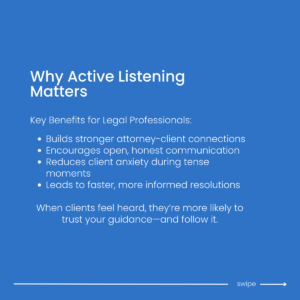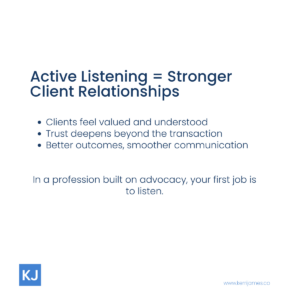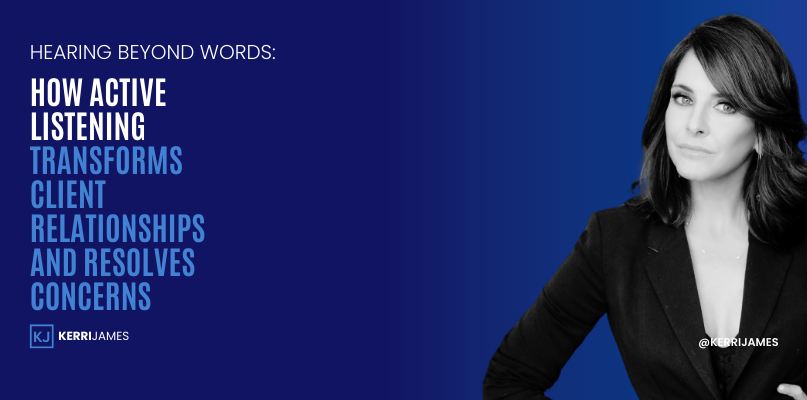In the fast-paced legal world, it’s easy to get lost in case details and deadlines. But have you considered how truly listening to your clients can transform your practice? Active listening goes beyond hearing words—it’s about fully engaging with your clients’ concerns, understanding their perspectives, and making them feel heard. This skill isn’t just about communication; it’s a powerful tool that helps de-escalate conflicts, build trust, and lead to faster, more effective resolutions. By creating an environment where clients feel understood and valued, you strengthen the foundation of the attorney-client relationship. I’ve seen firsthand how focusing on client communication can revolutionize a practice. In this post, I’ll explore how active listening can dramatically improve your interactions with clients and enhance your legal practice.
Beyond Hearing: The Essence of Active Listening
Active listening is a critical skill that goes beyond merely hearing words—it requires full engagement and attention. In the legal field, active listening ensures clients feel heard, understood, and valued. Unlike passive listening, which only absorbs words, active listening involves focusing on the speaker’s words, emotions, and nonverbal cues to grasp the deeper meaning of their message. This skill is essential for building strong attorney-client relationships and fostering effective communication and problem-solving.
At its core, active listening combines mental focus, empathy, and understanding. Lawyers who practice active listening engage deeply in the conversation, processing both verbal and nonverbal information. They recognize the client’s emotional state, observe body language, and respond in ways that address both the content and emotions behind the message. This approach helps create a deeper understanding of the client’s concerns.
Active listening extends empathy by tuning into the emotional currents of the conversation. Acknowledging and reflecting the client’s emotions shows that the lawyer values the individual, not just the legal matter at hand. This builds rapport and conveys that the lawyer truly cares about the client’s situation, laying the foundation for a trusting, collaborative relationship.
Mentors in the legal field, such as Ken Hardison, Chris Mullins, and Harlan Schillinger, emphasized the importance of understanding client needs. Their guidance shaped my approach to client interactions, where I prioritize listening and understanding before offering solutions. This ensures that my legal advice is not only sound but also aligned with the client’s emotional and personal needs.
The Impact on Client Relationships
When a lawyer truly listens to their client, the impact on the attorney-client relationship can be profound. Clients who feel genuinely heard are far more likely to trust their lawyer. Trust forms the foundation of every successful attorney-client relationship, and you build it by making the client feel genuinely understood. Active listening plays a central role in building that trust because it shows clients that their lawyer values them as individuals, not just as clients with legal issues.
When clients feel understood, they are more likely to be open and honest about their concerns. This transparency allows the lawyer to gather the full scope of the facts and nuances surrounding the case. Active listening allows the lawyer to ask the right follow-up questions, clarify any points of confusion, and fully comprehend the client’s perspective. This not only helps in developing a more effective legal strategy but also ensures that no critical information is overlooked, which could be the key to winning the case.
Moreover, active listening helps to reduce client anxiety. Legal issues are often stressful, and clients come to attorneys feeling overwhelmed, uncertain, and fearful. When clients feel that their lawyer is truly listening to them and understanding their situation, it can reduce their anxiety and make them feel more at ease. The act of listening shows empathy and makes clients feel validated in their emotions. This emotional validation is essential for helping clients manage the stress of their legal battles, and it fosters a more positive and productive relationship between the lawyer and the client.
Additionally, clients who feel understood are more likely to feel respected. Respect is another fundamental element in building strong relationships, and it is often achieved through active listening. When a lawyer listens carefully and responds thoughtfully, it sends the message that the client’s opinions, feelings, and perspectives are valued. This, in turn, encourages the client to engage in the legal process more fully, knowing that they are in a relationship of mutual respect.
Active listening enables lawyers to resolve client concerns quickly and effectively by fully understanding their perspective from the start. This allows lawyers to address issues before they escalate and identify the root cause of the concern, leading to faster resolutions.
For example, when a client expresses frustration, an active listener recognizes the underlying emotions and concerns. By acknowledging these feelings and reflecting back the concerns, the lawyer can offer solutions that directly address the client’s needs, leading to quicker problem-solving.
Active listening also prevents misunderstandings, which are often a major cause of delays. Misunderstandings can occur when lawyers assume they understand the client’s needs without engaging deeply. By actively listening, lawyers ensure they fully grasp the client’s concerns, reducing the likelihood of mistakes and saving time and resources by preventing misaligned expectations.
Clients who feel truly heard are more likely to trust their lawyer’s advice and be open to proposed solutions. When lawyers demonstrate a deep understanding of their clients’ concerns, it fosters a collaborative relationship where both parties work together toward a mutually beneficial outcome. It’s crucial to recognize that resolving issues involves addressing both legal and emotional needs. Clients who feel their emotional concerns are acknowledged through active listening are more likely to be satisfied with the results, regardless of the legal outcome.
Active listening also helps prevent conflicts by addressing client concerns early in the process. Many legal matters involve underlying tensions, and unaddressed emotional concerns can escalate into larger issues. By actively listening and acknowledging these concerns, lawyers can defuse potential conflicts, ensuring smoother and more efficient legal proceedings.
View Every Challenge as an Opportunity
View every client interaction, no matter how challenging, as an opportunity to improve communication and achieve better outcomes. Legal challenges—whether difficult clients, contentious negotiations, or complex issues—offer chances to address both legal and emotional needs. By actively listening and engaging, lawyers can find creative solutions that go beyond the surface and resolve underlying concerns.
This proactive, client-focused approach is especially useful during intake. Lawyers who take the time to actively listen uncover valuable insights into the client’s motivations and emotional state, allowing them to tailor legal strategies accordingly. When clients feel their lawyer genuinely cares about their well-being, it builds trust and enhances their overall experience with the legal process.
Diffusing Difficult Situations:
In the legal field, emotionally charged situations are inevitable. Clients often seek guidance during distressing times, bringing emotions like anger, fear, or frustration into the conversation. These emotions can cloud judgment, making effective communication challenging. As a lawyer, managing both your own and the client’s emotions can make a significant difference in how a situation unfolds. Active listening is one of the most effective tools for de-escalating tense interactions and fostering productive dialogue.
Active listening goes beyond hearing words; it requires fully engaging with the client by paying attention to tone, emotions, and body language. When clients feel heard, they are more likely to calm down and cooperate, which can transform a potentially volatile situation into a more positive, solution-oriented discussion. By validating the client’s emotions, you establish trust and pave the way for clearer communication.
In practice, when a client is upset, their anger or frustration can cloud their ability to communicate effectively. Many attorneys might instinctively defend their position or offer immediate solutions. However, this can escalate the situation, making the client feel misunderstood. Instead, by practicing active listening, you acknowledge the client’s emotions and de-escalate tension, making it easier to focus on addressing the issue.
Active listening is a powerful de-escalation tool because it shows empathy and validates the client’s feelings. Even if you disagree with the client’s perspective, demonstrating that you understand their emotions can calm the conversation. This approach creates a safe space for the client to express concerns without fear of judgment, allowing you to transition to problem-solving.
By consistently practicing active listening, you create a more relaxed environment. With emotions validated, both the lawyer and client can approach the conversation with a clearer mind, focusing on solutions rather than escalating emotions. This skill not only improves client interactions but also enhances your reputation as a lawyer who can handle high-stress situations effectively.
Developing strong communication skills, including active listening, is essential for any attorney. Investing in these skills helps ensure that you can navigate difficult conversations while maintaining a positive client relationship. Just as you invest time in legal strategies, investing in communication training is crucial for delivering the best service and building a client-centered practice.
The Components of Active Listening:
To master active listening, one must break it down into its core components. Each of these components is essential for creating meaningful, effective communication with clients, especially during emotionally charged situations. The following are the critical elements of active listening:
Paying Attention:
The first step in active listening is to give your full attention to the client. This means putting away distractions like your phone, closing your laptop, and focusing solely on the client. In today’s fast-paced world, where multitasking is commonplace, this may seem difficult, but it is crucial to let the client know that they are your primary focus. Simple gestures like maintaining eye contact, nodding in acknowledgment, and leaning forward slightly can demonstrate to the client that you are present and engaged.
Moreover, paying attention goes beyond just listening to words. A lawyer should also observe the client’s body language and emotional cues. Are they tense or relaxed? Do they seem anxious or confident? These subtle indicators can provide valuable insight into the client’s emotional state, which can guide how to respond effectively.
Reflecting and Clarifying:
Reflecting and clarifying help ensure you fully understand the client’s message. Paraphrasing with phrases like “What I’m hearing is…” or “So, if I understand correctly…” shows active engagement and confirms understanding.
When something is unclear, ask open-ended questions such as “Can you tell me more about that?” or “Could you explain what you mean by that?” This deepens your understanding and shows the client you’re genuinely invested in their concerns.
Empathy is a key part of active listening—it means stepping into the client’s shoes, acknowledging their emotions, and showing that you care about their experience, not just the legal issue. By validating their feelings, even without full agreement, you help build trust and create space for calmer, more productive conversations, especially when clients are overwhelmed or stressed.
Nonverbal Communication:
Nonverbal communication plays a key role in active listening. Your body language, facial expressions, and tone of voice all influence how clients receive your message. Use open, approachable posture, maintain eye contact, and avoid crossing your arms or appearing distracted. Nodding while the client speaks shows you’re engaged and reinforces your attention.
Your tone matters. A calm, steady voice can ease anxiety and defuse tension, even with upset clients. Nonverbal signals often speak louder than words and, when used well, build trust and strengthen communication.
Withholding Judgment:
Withholding judgment means refraining from making quick assumptions or forming responses before the client has finished speaking. It can be tempting to interrupt or jump to conclusions, but doing so undermines the listening process. It’s important to allow the client to express their full thoughts before responding, especially in emotionally charged situations.
Active listening requires that the lawyer listen with an open mind. Resist the urge to formulate a response while the client is talking. Instead, focus on understanding their perspective. Only after the client has finished speaking should you offer your thoughts, ensuring that your response is thoughtful and empathetic.
Practical Tips for Implementing Active Listening:
To integrate active listening into your practice, consider the following practical tips:
- Create a Dedicated Space:
When meeting with clients, choose a quiet and private space free from distractions. A comfortable setting can help put clients at ease, encouraging them to speak freely. A private environment also ensures confidentiality and fosters trust between you and the client. - Focus on the Client:
During meetings, make a conscious effort to give your full attention to the client. Put away your phone, shut down your computer, and avoid multitasking. When the client sees that you are fully engaged, it helps build a stronger connection and shows them that their concerns are a priority. - Use Reflective Statements:
When responding to a client, use reflective statements to demonstrate that you are actively listening. For example, “What I hear is that you’re feeling overwhelmed by the situation…” or “It sounds like you’re frustrated because you feel your options are limited.” These types of statements confirm that you are paying attention and help clarify any misunderstandings. - Ask Open-Ended Questions:
Open-ended questions encourage the client to provide more information, which can help you better understand their situation. Questions like, “How did that make you feel?” or “What are your main concerns about this?” allow the client to elaborate on their thoughts and emotions. These questions also help create a space for the client to reflect on their situation more deeply. - Practice Patience:
Active listening requires time and patience. It’s essential to resist the urge to rush through a conversation or interrupt the client. Allowing them the time to express themselves fully shows respect and can lead to more productive discussions. Be patient with yourself, as well; the more you practice active listening, the more natural it will become.
Example Scenario:
Imagine a client who is frustrated and angry about a perceived lack of progress in their case. Instead of becoming defensive or interrupting, the lawyer actively listens, allowing the client to vent their frustrations. The lawyer summarizes the client’s concerns and emotions: “It sounds like you’re frustrated with the pace and worried about the outcome. I understand.” This validation helps ease tension and shift the conversation toward solutions. Armed with that knowledge, I was able to design client interactions that spoke directly to their needs.
Final thoughts
Active listening is more than just a communication technique; it’s a fundamental skill that can transform your legal practice. By truly hearing your clients, you build trust, resolve concerns more effectively, and create stronger, more satisfying client relationships.  Clients aren’t just cases—they’re individuals with unique needs. By actively listening, we can serve them more effectively.
Clients aren’t just cases—they’re individuals with unique needs. By actively listening, we can serve them more effectively.










